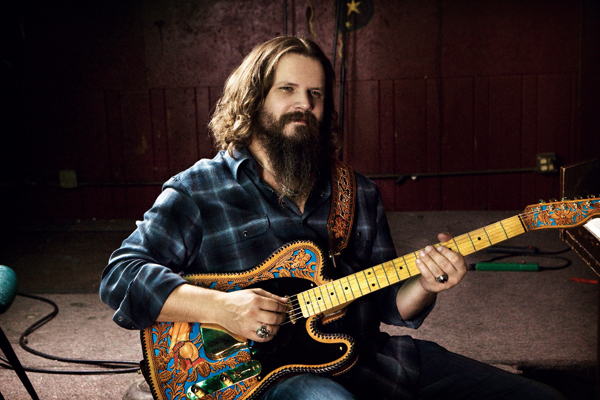Videos by American Songwriter
“Writing a song for her ain’t no different than writing one for anybody else if I sit down to write a song,” he says. “That’s kind of a letter I hope she keeps, and I hope she looks at it later on, and not just at three years old. When I wrote that, I think she hadn’t even turned three. It’s never been hard for her to go to bed. She always goes right out. I remember one night when we lived in ‘the cave’ – that’s what I called this space I was renting from a friend of mine – she woke up crying in the middle of the night. It was the first time she’d ever had a nightmare around me. It really hit me. That’s the one place I can’t protect her, right there. That song was to kind of calm her down and for her to know that if she needs me, I’m never that far away.”
Johnson quit college to enter the Marines, where he stayed for eight years. In 2000 he moved to Nashville, operated his own construction company for four years and made his first impression on country fans in 2005 with “The Dollar,” a modest hit on RCA. He soon landed lucrative cuts like Trace Adkins’ “Honky Tonk Badonkadonk” and George Strait’s “Give It Away.” But when Johnson parted ways with his label (and his wife), he holed up in a Nashville studio with his friends, billed as the Kent Hardly Playboys, to independently record an album.
The results caught the attention of Mercury Nashville, who partnered with Johnson to release it as That Lonesome Song in 2008. The album earned a Grammy nomination for best country album, landed on numerous year-end lists and was certified gold. The lead single, “In Color,” claimed song of the year trophies from the Academy of Country Music and the Country Music Association, climbed into the Top 10 at country radio and earned him two additional Grammy nominations.
In the song, a young man and his grandfather are going through vintage black-and-white photos of the Great Depression, World War II and a long-ago wedding day. As the older man reminisces with each image, he notes: “If it looks like we were scared to death / Like a couple of kids just trying to save each other / You should’ve seen it in color.” Johnson’s rich baritone conveys as much desperation as nostalgia in the lyrics.
Johnson co-wrote “In Color” with Lee Thomas Miller and James Otto, who also have credits on The Guitar Song. Otto describes Johnson’s personality like this: “He comes off as quiet if you just meet him but he’s one of the funnier people I’ve ever met. He’s extremely intelligent – like really, really bright. One of the things people don’t know about him is that his wit is extremely sharp and very quick. That’s a powerful tool as a writer as well. …. He’s just really an intelligent guy. They get it obviously from his songwriting, but from his outward appearance, that’s maybe not the first thing they would think of.”
On The Guitar Song, Johnson writes candidly about his conversations with God (“I Remember You”), yet draws on more conventional themes like simple upbringings and Southern roots, old guitars and musical heroes, long hauls and heartache. Throughout the interview, he is reluctant to give away too many details about the stories behind the songs, but he admits to an element of survival instinct in “Can’t Cash My Checks.”
“I don’t care what you’re doing, you’re going to have to wake up tomorrow and do it again, or you’re going to have to find a better way,” he says. “The fact remains that if you’re going to live, it’s not going to be easy and nobody owes you anything. But you do have to stay with it. You do have to keep recreating the same success over and over again if you’re ever going to get anywhere. I think that song right there points out that fact that it gets hard to make a living… and you’ve got to stay as true as you can to yourself. And stay as true as you can to your family and God and hopefully everything else will work out for the best.”
On “My Way to You,” the final track of the “White Album,” Johnson and co-writer Charlie Midnight describe the dark desires, broken dreams, endless miles, dirty barrooms and distant hope that all accompany a musician’s life. A romantic listener might think of the “You” as a lover. However, songwriters might not be wrong to think of the “You” as the song itself.
Asked if that song captures the ride he’s been on for the last few years, Johnson quickly and confidently replies: “It absolutely does. There were a lot of people who didn’t understand that the first time they heard it. And a lot of people did. It’s the way I view my whole life. Every single thing that I’ve done has been on my way.”
Craig Shelburne writes for CMT.com








Leave a Reply
Only members can comment. Become a member. Already a member? Log in.